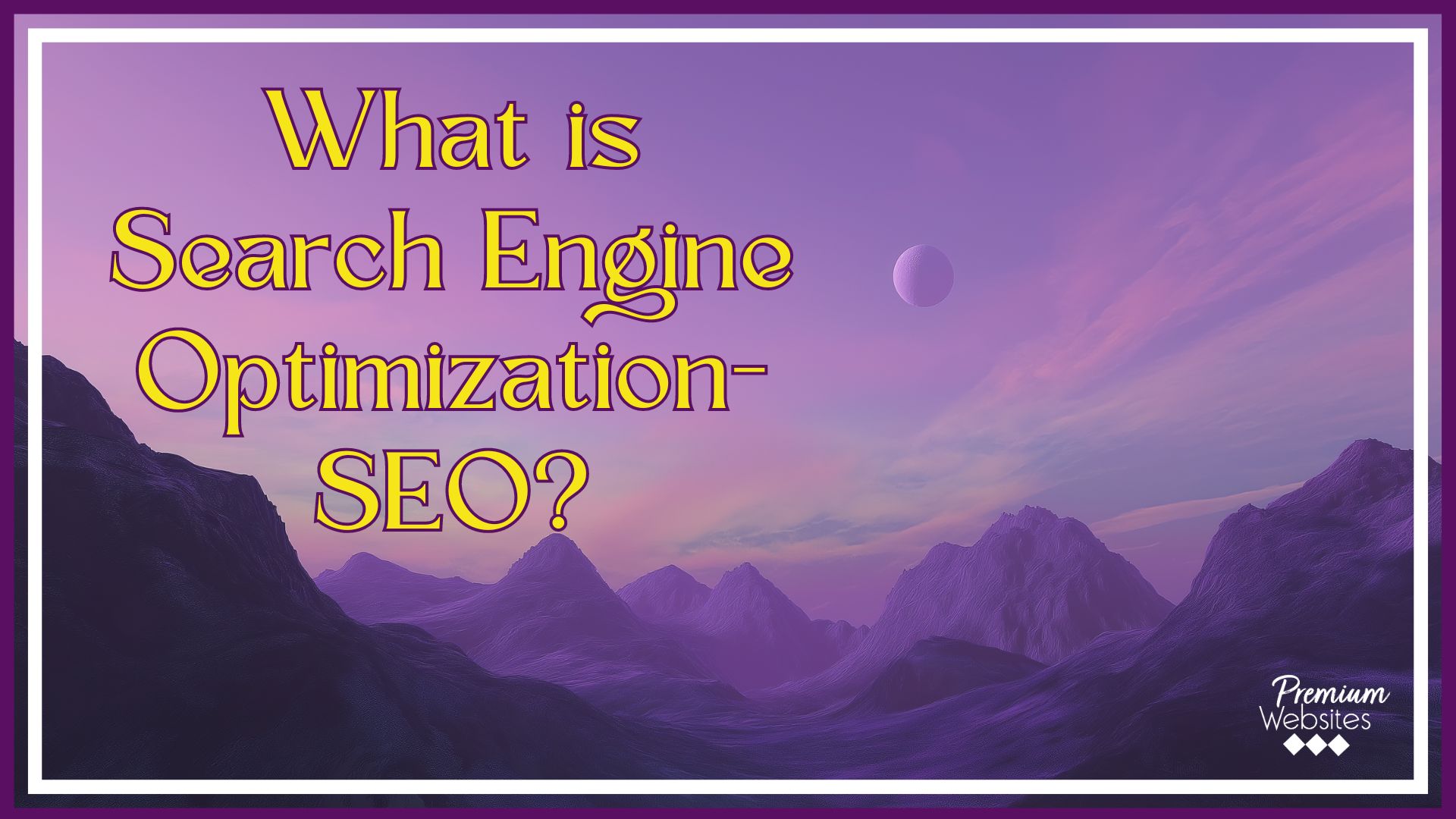
What is Search Engine Optimization (SEO)?
SEO is a crucial aspect of digital marketing that helps businesses improve their online presence and visibility. This blog post will delve into the importance of SEO for service-based business owners and explore various subgenres, such as e-commerce SEO, technical SEO, research, content creation, and implementation.
As you read on, you’ll discover effective on-page optimization techniques such as keyword incorporation in URLs, meta tag updates, internal linking improvements, and high-quality content creation. We will also discuss off-page strategies like backlink acquisition from reputable sources, social media sharing, and influencer networking to boost your website’s performance.
In addition to these tactics for what is search engine optimization success, we’ll cover how to choose the right keywords by analyzing competition and utilizing tools like AdWords Keyword Planner. Last but not least, we will provide insights into essential resources such as Google Search Console to monitor site performance and identify ranking issues effectively.
The Importance of Search Engine Optimization
Search engine optimization (SEO) is a crucial aspect of digital marketing that aims to improve your website’s visibility in search engines like Google. By focusing on both on-page and off-page optimization strategies, service-based business owners can significantly increase organic traffic levels, leading to better brand recognition and trust among potential customers.
Driving Real Business Results for Brands
One major benefit of implementing an effective SEO strategy is its ability to drive tangible results for businesses. When done correctly, SEO helps improve your website’s ranking on search engine results pages (SERPs), making it more likely that potential customers will find your site when searching for relevant products or services. This increased visibility leads to higher click-through rates and, ultimately, more conversions – whether that means generating leads, closing sales, or increasing newsletter sign-ups.
Increase Organic Traffic Levels
- Better SERP rankings: A well-optimized website ranks higher in search engine results pages, attracting more clicks from users who are actively looking for information related to your industry or niche.
- User engagement: High-quality content optimized with targeted keywords keeps visitors engaged longer on your site, reducing bounce rates and improving overall user experience.
- Social media shares: As part of a comprehensive SEO strategy, social media platforms can help amplify the reach of your content by encouraging users to share it with their networks – further boosting organic traffic levels over time.
Building Trust Among Users
Apart from driving measurable business outcomes through increased organic traffic, SEO also plays a vital role in building trust and credibility among users. By consistently appearing on the first page of search engine results for relevant queries, your website sends a strong signal to potential customers that it is an authoritative source of information within its niche or industry.
Establishing Brand Authority
- High-quality content: Creating valuable, informative content that addresses user needs and answers their questions helps establish your brand as an expert resource in your field.
- User-friendly design: A well-designed website with clear navigation and optimized load times ensures a positive user experience, further solidifying trust among visitors who may be considering doing business with you.
Incorporating both on-page and off-page optimization techniques into your overall marketing strategy can significantly improve the online presence of service-based businesses. In subsequent sections, we will delve deeper into various subgenres within SEO as well as specific strategies for implementing effective on-page and off-page optimizations.
SEO is a necessity for any enterprise wanting to remain viable in the present digital environment. With the right strategy, businesses can maximize their visibility and draw more customers than ever before. Subsequently, let us consider five areas of SEO that will aid you in commencing your own optimization plan.
Key Takeaway:
Search engine optimization (SEO) is essential for improving website visibility and driving real business results. By implementing effective on-page and off-page strategies, service-based businesses can increase organic traffic levels, establish brand authority, and build trust among users through high-quality content and user-friendly design.
Five Subgenres within SEO
Five subgenres within SEO work together to create an effective strategy that can significantly improve a website’s online presence. These include E-Commerce SEO, Technical SEO, Research, Creating new content, and Recommending or implementing changes to existing pages.
E-commerce SEO for online stores
E-commerce SEO is specifically tailored for businesses with online stores that want to boost their visibility in search engine results pages (SERPs). It involves optimizing product descriptions, category pages, and site structure to ensure a seamless shopping experience while maximizing organic traffic levels.
Technical SEO
Small businesses often require technical SEO, which focuses on more complex technical aspects of search engine optimization. These strategies include addressing issues such as duplicate content, optimizing page setup, and properly implementing schema markup for better SERP display.
Researching keywords and competition
An essential aspect of any successful SEO strategy is conducting thorough keyword research. By analyzing your competitors’ websites and identifying high-performing keywords relevant to your industry or niche market segment, you can craft targeted content explicitly designed around these terms, increasing organic rankings over time.
- Gauging search volume: Understanding how many people are searching for specific phrases/terms helps prioritize which ones to focus on most heavily.
- Analyzing competition: Assessing competitor performance within your niche market segment can provide valuable insights into potential growth opportunities or areas requiring improvement.
Content creation for user engagement
Producing engaging content is essential to any SEO strategy, as it can capture the attention of both users and search engines, resulting in increased organic rankings. By producing informative and original articles, blog posts, videos, or other multimedia resources, you’ll be able to capture the attention of both users and search engines alike. This will ultimately lead to improved organic rankings over time as more people share these materials across various platforms, such as social media.
Implementing changes based on analysis
An effective SEO campaign requires ongoing monitoring and adjustments based on data-driven insights. Utilizing tools like Google Analytics and Search Console – service-based business owners can identify trends within their website’s performance metrics. This allows them to make informed decisions regarding future optimization efforts.
- A/B testing: Experiment with different variations of webpage elements (such as headlines or calls to action) to determine which version generates better results.
- CRO (Conversion Rate Optimization): Analyze how visitors interact with your site and implement changes designed specifically to improve conversion rates, resulting in increased revenue generation.
Search engine optimization is a multifaceted and continuously changing discipline, requiring an in-depth knowledge of its five subfields for successful implementation. Effective on-page optimization is necessary to ensure a website’s successful indexing by search engines, maximizing visibility.
Key Takeaway:
Search engine optimization (SEO) has five subgenres, including Ecommerce SEO for online stores, Technical SEO, researching keywords and competition to create targeted content, creating engaging content to improve organic rankings over time, and implementing changes based on data-driven insights.
On-page Optimization Techniques
On-page optimization is a crucial aspect of search engine optimization that focuses on improving various elements within individual web pages to help them rank higher in search engines. By incorporating these techniques, service-based business owners can significantly enhance their website’s visibility and attract more organic traffic.
Keyword-rich URLs
An essential step in on-page SEO is creating keyword-rich URLs for your web pages. This means using words related to your page’s content within the URL structure, so search engines can better comprehend what it is about. For example, if you offer plumbing services, an optimized URL might look like this: https://www.example.com/plumbing-services/leak-repair.
Meta tag updates
Updating meta tags with accurate and relevant information helps improve your site’s visibility in search engine results pages (SERPs). The two most important meta tags are the title and meta description. Ensure that both contain target keywords while accurately describing each page’s content.
Smooth site navigation
A well-structured website with smooth internal linking significantly enhances user experience and boosts SEO efforts. Ensure all menus are easy to navigate, links work correctly, and breadcrumbs are implemented where necessary. This will not only make it easier for users to locate the desired content but also facilitate search engines’ effective indexing of your site.
High-quality keyword-focused content
- Create engaging content that provides value to readers while incorporating appropriate keywords naturally throughout the text.
- Avoid overusing or “stuffing” keywords, as this can negatively impact rankings due to Google penalizing such practices.
- Use headings (H1, H2, etc.) to break up content and include keywords where relevant for better readability and SEO benefits.
Optimized image titles
Incorporating optimized images with descriptive titles can enhance your website’s overall SEO. Ensure all images have appropriate file names containing target keywords and utilize the alt attribute to describe each image. This helps search engines understand the context of the visual elements on your site while also improving accessibility for users who rely on screen readers.
On-page optimization techniques are essential for increasing a website’s visibility in search engine results pages. Off-page optimization strategies, such as building quality backlinks and sharing social media content, can further increase the chances of success.
Key Takeaway:
To improve your website’s visibility and attract more organic traffic, service-based business owners should focus on on-page optimization techniques. This includes creating keyword-rich URLs, updating meta tags with accurate information, ensuring smooth site navigation, producing high-quality content with appropriate keywords and headings, and optimizing image titles. By implementing these strategies effectively you can enhance user experience while also boosting SEO efforts to help your website rank higher in search engine results pages (SERPs).
Off-page Optimization Strategies
Off-page optimization focuses on activities outside of your website aimed at increasing its authority within its niche or industry through backlinks from other reputable sites or social media shares. Building relationships with influencers who may share their content across multiple platforms ultimately helps increase organic rankings over time due to increased credibility amongst both users and algorithms alike.
Building Quality Backlinks
A crucial aspect of off-page SEO is building quality backlinks. These links from other websites point to your site, which search engines view as a vote of confidence in your content. To build these valuable connections, reach out to relevant blogs and websites in your industry for guest posting opportunities or collaborations. You can also get our WebHub package to create a larger digital footprint that links to your website.
Social Media Sharing
Utilizing social media platforms to promote your content can enhance its visibility. Share blog posts, articles, and promotional materials on platforms like Facebook, Twitter, LinkedIn, and Instagram. Encouraging followers to engage with the material by liking it or leaving comments will further amplify its reach.
Influencer Outreach
- Identify: Research potential influencers within your niche with an engaged audience interested in topics related to your business.
- Contact: Reach out via email or social media channels expressing interest in collaborating on projects such as sponsored posts or product reviews.
- Maintain Relationships: Nurture ongoing relationships with key influencers so they continue supporting future campaigns when opportunities arise.
Remember, an “influencer” does not need to have millions of followers. Look for micro-influencers with smaller audiences who are big in your industry.
Guest Blogging Opportunities
Guest blogging is another effective off-page SEO strategy that involves writing articles for other websites within your industry. By creating content for different websites, you can build backlinks and reach a new audience that may be interested in your business. When seeking guest posting opportunities, focus on sites with high domain authority and an engaged readership for maximum impact.
Off-page optimization strategies are essential for any successful SEO campaign, as they can help build authority and trust with search engines. Conducting thorough keyword analysis can ensure that your content is reaching the desired viewers more efficiently.
Key Takeaway:
Off-page optimization strategies such as building quality backlinks, social media sharing, influencer outreach, and guest blogging opportunities are crucial for increasing a website’s authority within its niche or industry. By leveraging these tactics, businesses can improve their organic rankings over time and increase credibility among users and algorithms alike.
Choosing the Right Keywords
Selecting relevant keywords is crucial for successful SEO campaigns since they help drive targeted traffic to specific pages based on what people are searching for online. Utilize tools provided by Google, such as the AdWords Keyword Planner tool, to test keyword effectiveness and gauge potential competition levels before committing fully to certain phrases/terms.
Targeted Keyword Research
To begin your research, brainstorm a list of terms related to your service-based business that potential customers might use when searching online. Consider their needs, pain points, and how your services can address them. To create the list, use tools like Google Trends or Answer The Public. Once you have a list of possible keywords, utilize tools like Ahrefs’ Keywords Explorer or Moz’s Keyword Explorer to analyze search volume and competitiveness.
Analyzing Search Volume
The search volume represents the number of times users search for a particular keyword within a given time frame. It’s essential to target keywords with sufficient search volume so that you can attract enough organic traffic to make an impact on your bottom line. However, remember that high-volume keywords often come with increased competition – making it more challenging to rank well in SERPs (Search Engine Results Pages).
Assessing Competition
- Evaluating competitors: Look at websites currently ranking well for your chosen keywords; these sites represent direct competition vying for the same audience attention as yours. Analyze their content quality and backlink profiles using tools like Ahrefs or Moz Pro—this will give insight into areas where improvements could be made within your own site.
- Keyword difficulty: Many SEO tools provide a metric called “keyword difficulty” that measures how challenging it is to rank for a specific keyword. Higher scores indicate more competition, while lower scores suggest more accessible ranking opportunities. Aim for keywords with moderate difficulty levels to strike the right balance between search volume and competitiveness.
Using Google’s AdWords Keyword Planner
The Google AdWords Keyword Planner is an invaluable resource for finding new keyword ideas and analyzing their potential effectiveness within your SEO strategy. By entering your initial list of brainstormed terms into the tool, you’ll receive additional suggestions based on relevancy and user intent, helping refine and expand upon existing ideas further. Additionally, this tool provides valuable data such as average monthly searches, competition level, and suggested bid prices (if considering paid advertising).
Selecting the appropriate keywords is vital to making your website more search engine friendly. With proper research and analysis, you can create an effective keyword strategy that will help increase visibility on SERPs. Leveraging SEO tools and resources can further optimize your website by monitoring performance with Google Search Console, identifying ranking issues, and implementing recommended improvements.
Leveraging SEO Tools and Resources
As your marketing efforts progress, consider additional SEO tools and resources that can help further optimize your website. One of the most valuable tools available is Google Search Console, a free tool provided by Google that allows webmasters to monitor their site’s performance in search results, identify issues affecting rankings, and receive recommendations on how to improve the overall user experience. This tool is great for finding issues; however, it will not help you fix them.
Monitoring with Google Search Console
By using Google Search Console, you can gain insights into how your website is performing in SERPs and uncover data such as impressions, clicks, click-through rates (CTR), and average positions for specific keywords. Regularly monitoring these metrics will help you understand which aspects of your SEO strategy are working effectively and where improvements may be needed.
Identifying Ranking Issues
Beyond tracking performance metrics, Google Search Console also helps identify potential ranking issues that could negatively impact your website’s visibility in search engines. For example, it can detect crawl errors or broken links within your site structure—both of which hinder smooth navigation for users and algorithms alike. By addressing these problems promptly through proper maintenance practices like fixing 404 errors or updating outdated content regularly, you’ll ultimately boost overall SEO success rates across all platforms.
Implementing Recommended Improvements
- Title tags: Ensure each page has a unique title tag containing relevant keywords, keeping it under 60 characters long so it displays correctly within SERPs.
- Description tags: Craft compelling meta descriptions between 150-160 characters long, including primary keyword phrases/terms related specifically to individual webpage topics at hand.
- Heading tags: Use heading tags (H1, H2, etc.) to structure your content and help users and search engines understand the hierarchy of information on each page.
- Image optimization: Compress images without sacrificing quality using tools like TinyPNG. Add descriptive alt text containing relevant keywords, and use meaningful file names that reflect the image’s content.
In addition to Google Search Console, numerous other SEO tools can further enhance your optimization efforts. Some popular options include Ahrefs, which offers comprehensive backlink analysis & keyword research capabilities, or Moz Pro, a suite of advanced SEO analytics features designed specifically to help businesses improve their online presence across various digital channels. By effectively leveraging these resources, you’ll be well-equipped to achieve greater success within today’s highly competitive marketplace environment.
Frequently Asked Questions
What are search engine optimization articles?
These articles incorporate relevant keywords, proper formatting, and informative content that helps the site rank higher in organic search results. They aim to provide value for readers while adhering to SEO best practices.
What is search engine optimization, and why is it important?
Search engine optimization (SEO) refers to enhancing a website’s online presence through various techniques to improve its ranking on search engines’ result pages. It is crucial because higher rankings increase traffic, brand awareness, credibility, and, ultimately, more business opportunities for service-based businesses.
How would you explain SEO to a beginner?
In simple terms, SEO involves optimizing your website to appear higher in search engine results when people look for specific keywords related to your services or products. This includes making changes on-page (content and structure) and off-page (external factors such as backlinks). The goal is to attract more visitors who can become customers or clients.
Conclusion
Search engine optimization is a powerful tool for service-based business owners. By understanding the basics of on-page and off-page optimization, they can make informed decisions to increase their website visibility and reach more potential customers. Through careful analysis of metrics like page views, click-through rates, and bounce rates, businesses can measure SEO success over time. Finally, following best practices, such as using keywords strategically in content creation or building high-quality backlinks from authoritative sources, will help optimize search engine rankings even further.
Let Premium Websites, Inc. help you get your website found by optimizing it for search engines. Our experienced team will provide the highest quality of SEO services to ensure maximum visibility and success online.



